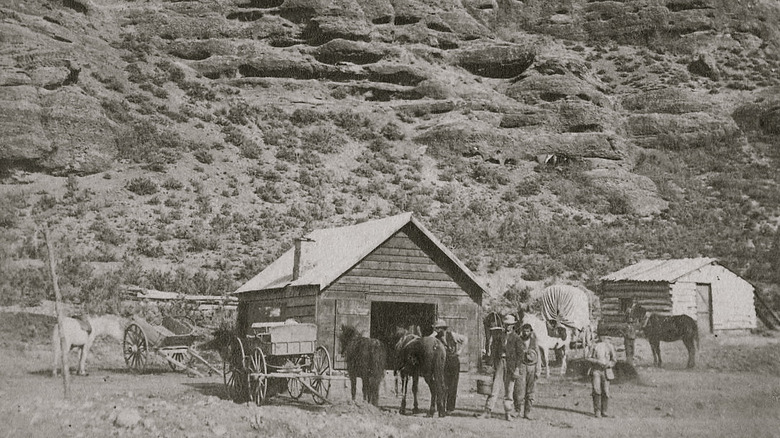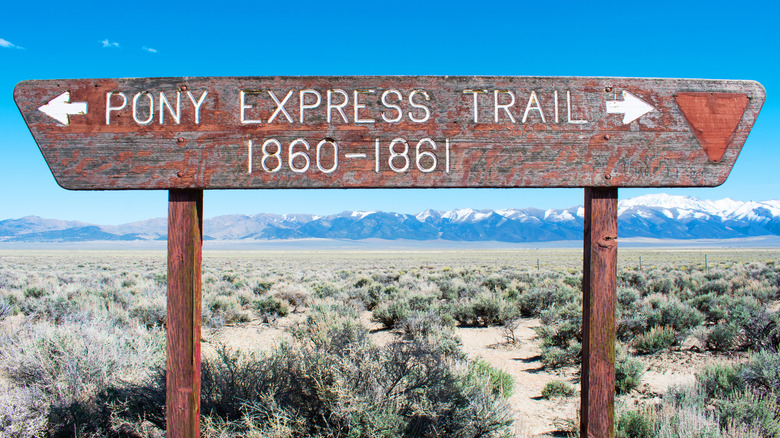Why The Pony Express Was Around For Fewer Than Two Years
The Gold Rush of 1849 saw thousands of people migrating to California to get their hands on precious gold. Many left their homes abruptly, with some borrowing money for travel and mortgaging their houses to strike it rich in the west. According to Young American Republic, California's population of about 14,000 ballooned to more than 100,000 by the end of 1849, and just three years later, it was upwards of 300,000 people.
Communication was necessary, and at that time, it took several weeks, if not months, for mail to be delivered to California. As reported by the Smithsonian's National Postal Museum, the Pacific Mail Steamship Company was given the contract for mail delivery. Mail traveled to Panama from New York via a ship, and then via rail or stagecoach and back on a ship headed to San Francisco. Mail was delivered in about three weeks, but that was the best-case scenario; unavoidable circumstances and bad conditions often delayed deliveries.
Three men — William Hepburn Russell, William Bradford Waddell, and Alexander Majors — had an existing freight business, and they had contracts with the government to transport army supplies to the west (via St. Joseph Missouri). Russell thought that it would be a good idea to provide a faster service for delivering mail, and the Pony Express Company was established on April 3, 1860.
The Pony Express service
Prior to the establishment of the Pony Express, the Butterfield Overland Mail Company had already been operating for two years. The company, as noted by Frontier Life, was able to deliver mail in 25 days following the Oxbow Route from Missouri to California using stagecoaches, but there were also delays.
According to the Smithsonian's Postal Museum, the Pony Express had more than 400 ponies. About 200 stations were constructed 10 miles from each other where riders handed over mail to other riders in a relay until the mail reached the final destination. A job post published in the Sacramento Union read that interested parties must be "familiar with the management of horses, as hostlers, or riders on the Overland Express Route via Salt Lake City" and promised a payment of $50 a month, approximately $1,800 in today's money (via National Park Service).
Pony Express riders were able to deliver mail in 10 days on average. Its fastest known delivery time was in March 1861 when Abraham Lincoln's inaugural address was delivered from Nebraska to California in less than 8 days, as noted by History. The riders hired were small and thin to lessen the weight the ponies had to carry, which allowed them to travel at their maximum speed. Using the Pony Express had its advantages, but it wasn't for everyone. The initial cost to send mail was $5 and it was brought down to $1, but still, it was costly for most people. The majority of the mail sent through the service included documents, newspaper reports, and government letters.
The end of the Pony Express
The Pony Express crushed its competitors when it came to how fast mail was delivered, but the business was far from profitable. According to History, the service had to shut down for a time due to the Pyramid Lake War, which cost the company $75,000. The operation, although efficient, was costly to maintain, and the Pony Express was never awarded mail contracts from the government. Christopher Corbett, who wrote a book about the Pony Express, told Vox, "It hemorrhaged money from the first day. It was a bit of a madcap idea from the get-go . . . the structure of the business was deeply flawed."
Another reason for the short-lived Pony Express was the telegraph. On October 24, 1861, the first transcontinental telegraph line was completed, which provided a link from the east to the west and eliminated the need for sending mail via horseback (via History). Two days later on October 26, the Pony Express was terminated. Official ledgers noted that the company lost about $200,000 during its 18 months in business. Today, the National Pony Express Association, a non-profit organization, holds annual 10-day rides to deliver letters following the route that the Pony Express riders took to commemorate this important part of history.


